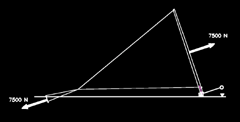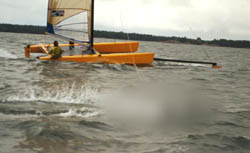The Swedish Speed Sailing Challenge
The Paravane Speedsailer
 We have cancelled the heeling moment by using a paravane (a hydrofoil
attached on the end of a wire, that pulls out to one side when the craft
moves forwards) Our paravane is connected to the rig by wires, so it's
hydrodynamic force acts near the sail's center of effort. Hence, the
heeling moment from the sail is cancelled, and the aerodynamic force in
the sail can be several times larger than the weight of the entire boat.
We have cancelled the heeling moment by using a paravane (a hydrofoil
attached on the end of a wire, that pulls out to one side when the craft
moves forwards) Our paravane is connected to the rig by wires, so it's
hydrodynamic force acts near the sail's center of effort. Hence, the
heeling moment from the sail is cancelled, and the aerodynamic force in
the sail can be several times larger than the weight of the entire boat.
 Paravane-stabilization is an old idea, but we have improved the design,
so our paravane follows the water's wavy surface better than previous
designs. At top speed our paravane can handle a vertical acceleration up
to +/- 20 g.
The flexible connection between the boat and the paravane allows the
paravane to follow the waves while the main hull can fly between the
wave-crests. Hence, our sailing craft is less sensitive to waves than
boats with centerboards at the hull that has to follow the waves to avoid
loosing grip in the water.
We use a bowsprit with a planing ski to avoid pith-pooling that would
otherwise be a problem with the large driving force that the paravane
stabilization enables.
The boat is designed for high-speed sailing only on starboard tack.
The rig is a single asymmetric stiff all carbon-fiber wing.
The small extra hull that looks like a keel-bulb is for stability before
the paravane is launched. At speed the extra hull lifts out of water, and
is therefore designed only to have a low aerodynamic drag.
The boat will be sailed single-handed.
Total weight without crew is 110 kg. The main-hull is 5.2 x 0.6 m, sail-area
9.0 m^2. Height of the wing-sail is 11 m.
Paravane-stabilization is an old idea, but we have improved the design,
so our paravane follows the water's wavy surface better than previous
designs. At top speed our paravane can handle a vertical acceleration up
to +/- 20 g.
The flexible connection between the boat and the paravane allows the
paravane to follow the waves while the main hull can fly between the
wave-crests. Hence, our sailing craft is less sensitive to waves than
boats with centerboards at the hull that has to follow the waves to avoid
loosing grip in the water.
We use a bowsprit with a planing ski to avoid pith-pooling that would
otherwise be a problem with the large driving force that the paravane
stabilization enables.
The boat is designed for high-speed sailing only on starboard tack.
The rig is a single asymmetric stiff all carbon-fiber wing.
The small extra hull that looks like a keel-bulb is for stability before
the paravane is launched. At speed the extra hull lifts out of water, and
is therefore designed only to have a low aerodynamic drag.
The boat will be sailed single-handed.
Total weight without crew is 110 kg. The main-hull is 5.2 x 0.6 m, sail-area
9.0 m^2. Height of the wing-sail is 11 m.
 The summer 2001 we tested the paravane on a 20 ft catamaran
(Marström
M-20). The top-speed was around 30 knots in a short gust of 18 knots. We
also tested the planing ski on a bowsprit on the M-20.
The tests confirmed that the paravane system was reasonably easy to
handle, that the boat was perfectly stable and that the bowsprit with
planing ski gave enough longitudinal stability.
The purpose-designed wing-section has been tested in a wind tunnel to
verify the high-lift performance.
The improvements over the M-20 catamaran that will make on our
speed-record challenger substantially faster are:
1) A planing hull that will only have a fraction of the drag of the
non-planing catamaran hulls at speed above 30 knots.
2) A stiff asymmetric wing-sail that will not deflect under high
sail-forces as the traditional catamaran sail did.
3) Lower aerodynamic drag, which is possible thanks to a pure one-tack
design.
With these improvements our sailing craft is estimated to make 50 knots in
16 knots of wind.
The summer 2001 we tested the paravane on a 20 ft catamaran
(Marström
M-20). The top-speed was around 30 knots in a short gust of 18 knots. We
also tested the planing ski on a bowsprit on the M-20.
The tests confirmed that the paravane system was reasonably easy to
handle, that the boat was perfectly stable and that the bowsprit with
planing ski gave enough longitudinal stability.
The purpose-designed wing-section has been tested in a wind tunnel to
verify the high-lift performance.
The improvements over the M-20 catamaran that will make on our
speed-record challenger substantially faster are:
1) A planing hull that will only have a fraction of the drag of the
non-planing catamaran hulls at speed above 30 knots.
2) A stiff asymmetric wing-sail that will not deflect under high
sail-forces as the traditional catamaran sail did.
3) Lower aerodynamic drag, which is possible thanks to a pure one-tack
design.
With these improvements our sailing craft is estimated to make 50 knots in
16 knots of wind.
| Spec. Paravane Speed Sailer | |
|---|---|
| Design | Alexander Sahlin and Jens Österlund |
| Length | 9 m |
| Weight | 110 kg |
| Sail area | 9 m^2 |
| Wing height | 11 m |
| Beam | 21 m |
| Materials | Pre-preg carbon/epoxy and nomex honeycomb |
 www.marstrom.com
www.marstrom.com
 www.silva.se
www.silva.se www.ocke.se
www.ocke.se www.rupertmarine.com
www.rupertmarine.com www.kgksuzuki.se
www.kgksuzuki.se www.epotex.se
www.epotex.se www.hp.se
www.hp.se ni.com/sweden
ni.com/sweden www.vinova.se
www.vinova.se www.robship.se
www.robship.se